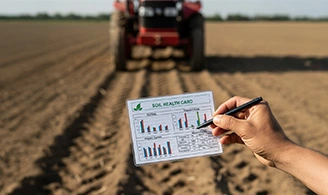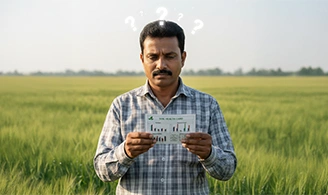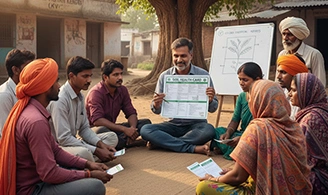How Soil Health Card Scheme Helps Farmers Improve Crop Yields

Agriculture is the backbone of India, supporting nearly half of the population with livelihood and food security. Yet, the foundation of this agriculture—the soil—is under increasing stress. Over the years, farmers have relied heavily on chemical fertilizers, intensive cropping, and traditional practices without scientific inputs. This has led to soil degradation, loss of organic matter, and nutrient deficiencies. Recognizing these challenges, the Government of India launched the Soil Health Card (SHC) Scheme, a pathbreaking initiative to empower farmers with scientific knowledge about their soil and improve productivity.
This blog provides a detailed guide to the Soil Health Card Scheme, its objectives, working mechanism, benefits, and how it helps farmers enhance crop yields while protecting the environment.
Why Soil Health Matters for Agriculture

Healthy soil is the foundation of sustainable farming. It not only anchors crops but also provides essential nutrients, water, and a balanced ecosystem for plants to thrive. Unfortunately, many Indian farmers lack scientific knowledge about their soil’s condition. They often select crops or apply fertilizers based on guesswork or tradition rather than evidence.
Problems that Indian soils face today include:
- Nutrient deficiencies: Widespread deficiencies of macro, secondary, and micronutrients have emerged (Singh et al., 2015; Rai & Singh, 2018).
- Loss of organic matter: Conversion of natural ecosystems into agricultural land under intensive cultivation depletes soil organic carbon (Kumar et al., 2013).
- Sulphur and micronutrient deficits: Sulphur application influences nutrient uptake, while deficiencies in micronutrients like zinc contribute to human malnutrition (Kumar et al., 2019; Girija Veni et al., 2019).
- Excessive fertilizer use: Heavy reliance on nitrogenous fertilizers reduces soil fertility over time.
- Erosion and degradation: Improper land management and water erosion reduce soil productivity.
Without corrective measures, these problems can reduce crop yields, affect food security, and burden farmers financially. The Soil Health Card Scheme was designed to address these challenges systematically.
What is the Soil Health Card Scheme?

Launched in 2015, the Soil Health Card Scheme provides farmers with a printed report card detailing the nutrient status of their soil and recommendations for fertilizer use and corrective practices. The idea is simple yet powerful: know your soil, nourish it right, and grow better crops.
Each Soil Health Card contains information on 12 key parameters:
- Macronutrients: Nitrogen (N), Phosphorus (P), Potash (K)
- Secondary nutrient: Sulphur (S)
- Micronutrients: Zinc, Iron, Copper, Manganese, Boron
- Soil properties: pH, Electrical Conductivity (EC), Organic Carbon
By analyzing these parameters, farmers receive customized advice on which crops are best suited to their fields, what nutrients are deficient, and the exact dosage of fertilizers required.
Key Features of the Soil Health Card Scheme

- Nationwide Coverage: The scheme aims to cover 14 crore farmers across India.
- Universal Reach: Every part of the country is included, ensuring no farmer is left behind.
- Regular Updates: Farmers receive a soil health card once every three years.
- Detailed Soil Report: Each card lists nutrient status, additional soil properties, and corrective measures.
- On-Ground Support: Farmers are guided by experts from Krishi Vigyan Kendras (KVKs), mobile soil testing labs, and state agriculture departments.
How Does the Scheme Work?

The Soil Health Card Scheme follows a step-by-step process to provide farmers with actionable soil insights:
- Soil Sample Collection
- Samples are collected from farmers’ fields twice a year—after Rabi and Kharif crops, or when fields are bare.
- Trained staff or farmers collect soil from 15–20 cm depth using a “V”-shaped cut, taking samples from four corners and the center of the field.
- Laboratory Testing
- Samples are sent to soil testing laboratories where experts analyze nutrient levels and soil properties.
- Report Generation
- Results are compiled into a Soil Health Card, highlighting nutrient sufficiency/deficiency and providing tailored recommendations.
- Advisory Support
- Along with the card, farmers receive guidance on how to use fertilizers efficiently, adopt organic manures, and improve soil health.
- Renewal
- Every three years, farmers receive a fresh soil health card to track changes and improvements.
Why the Scheme is Needed

Before this scheme, soil testing in India suffered from:
- Lack of uniform standards: Different states used different norms for testing.
- Limited awareness: Many farmers didn’t know where to test their soil or how to use the results.
- Low affordability: Poor farmers couldn’t pay for soil analysis.
The SHC Scheme created a centralized and standardized system, ensuring farmers across India received uniform, credible soil reports free of cost.
Benefits of the Soil Health Card Scheme

The Soil Health Card Scheme delivers multiple benefits to farmers, agriculture, and the environment:
- Improved Crop Yields
With accurate data, farmers apply the right fertilizers in the right quantity. This avoids overuse or underuse and boosts crop productivity.
- Cost Savings
By eliminating guesswork, farmers save money on unnecessary fertilizers. Balanced use ensures better returns at lower costs.
- Enhanced Soil Fertility
Judicious use of fertilizers, combined with organic manures and bio-fertilizers, improves soil structure, organic matter, and long-term fertility.
- Nutrient Management
The SHC helps manage deficiencies of micronutrients like zinc, boron, and iron, which are often ignored but vital for crop health.
- Environmental Protection
Balanced fertilizer use reduces chemical runoff into water bodies, prevents soil toxicity, and curbs greenhouse gas emissions.
- Human Health Benefits
By addressing deficiencies like zinc in soil, SHC indirectly helps combat micronutrient malnutrition in human diets.
- Informed Decision-Making
Farmers gain scientific insights into which crops are best suited to their land, leading to smarter crop choices and better market returns.
How Soil Health Cards Aid Farmers in Practice

A Soil Health Card is more than just a piece of paper; it is a decision-making tool. For example:
- A farmer in Punjab may discover that his soil is deficient in zinc. Based on the SHC, he applies zinc sulphate along with urea, leading to healthier wheat crops.
- In Maharashtra, a farmer finds high soil pH levels, and the card suggests adding gypsum to neutralize alkalinity, making nutrients more available to crops.
- A farmer in Odisha, using SHC recommendations, reduces excess nitrogen use and prevents lodging in rice crops, improving yields.
These real-life applications show how SHCs translate into tangible productivity gains.
Challenges in Implementation

While the scheme is transformative, some challenges remain:
- Awareness Gap
- Many small and marginal farmers are unaware of how to interpret soil health cards.
- Infrastructure Limitations
- Soil testing laboratories are sometimes insufficient or slow in processing samples.
- Adoption Barriers
- Some farmers continue traditional practices despite receiving scientific recommendations.
- Maintenance Issues
- Soil fertility improvements require long-term practices like composting and crop rotation, which some farmers neglect due to lack of resources.
Practical Need of the Scheme in Indian Context

Indian soils face unique pressures:
- High cropping intensity leading to nutrient depletion.
- Low organic matter content due to reduced use of green manures.
- Over-reliance on chemical fertilizers causing imbalances.
- Erosion and degradation reducing productivity.
The SHC Scheme promotes Integrated Nutrient Management (INM)—a blend of chemical fertilizers, micronutrients, organic manures, and bio-fertilizers—to restore soil health sustainably.
How Farmers Can Use the SHC Effectively

- Read the Card Carefully
- Understand the nutrient status (sufficient or deficient) for each parameter.
- Follow Recommendations
- Apply the suggested fertilizers in the right quantity and at the right time.
- Adopt Complementary Practices
- Use crop rotation, organic manures, and mulching to maintain long-term soil health.
- Consult Experts
- Approach Krishi Vigyan Kendras or agriculture officers for clarifications.
- Monitor Progress
- Compare yields before and after SHC recommendations to assess improvements.
The Road Ahead: Strengthening the SHC Scheme

To maximize the scheme’s impact, some steps can be taken:
- Increase Awareness Campaigns: Use local languages, farmer field schools, and mobile apps to educate farmers.
- Strengthen Soil Labs: More mobile soil testing units and faster processing.
- Digital Integration: Link SHC data with online portals and apps for easy farmer access.
- Encourage Organic Farming: Promote composting, bio-fertilizers, and green manures.
- Farmer Training Programs: Regular workshops to interpret SHC and adopt corrective measures.
Conclusion

The Soil Health Card Scheme is a landmark initiative in Indian agriculture. By providing farmers with scientific knowledge about their soil, it empowers them to make informed decisions, improve crop yields, and protect the environment.
Healthy soil means healthy crops, prosperous farmers, and a secure nation. With regular monitoring, expert guidance, and farmer participation, the SHC Scheme is not just improving yields but also laying the foundation for sustainable agriculture in India.
As farmers across the country embrace this scheme, India moves closer to the vision of a self-reliant, food-secure future—one where every crop grows from soil that is cared for, nourished, and thriving.
















